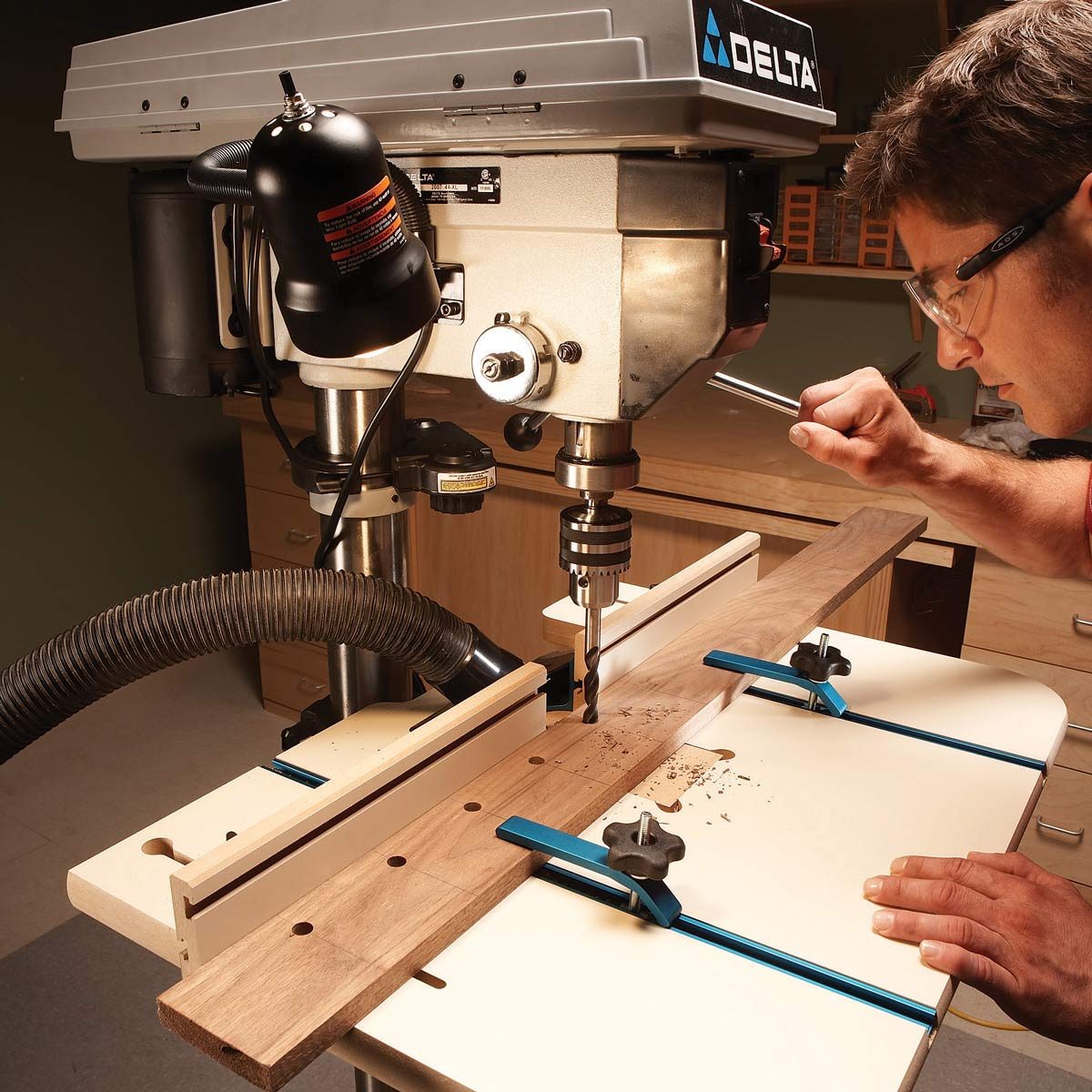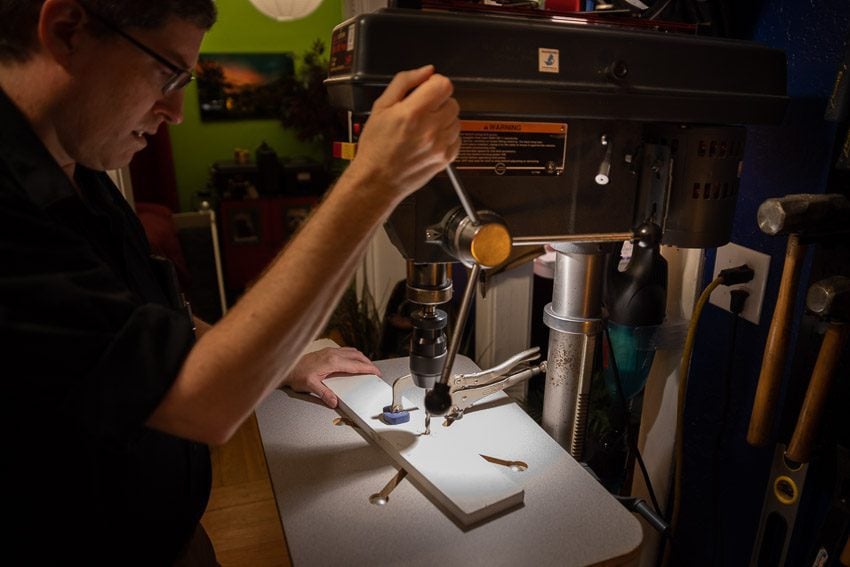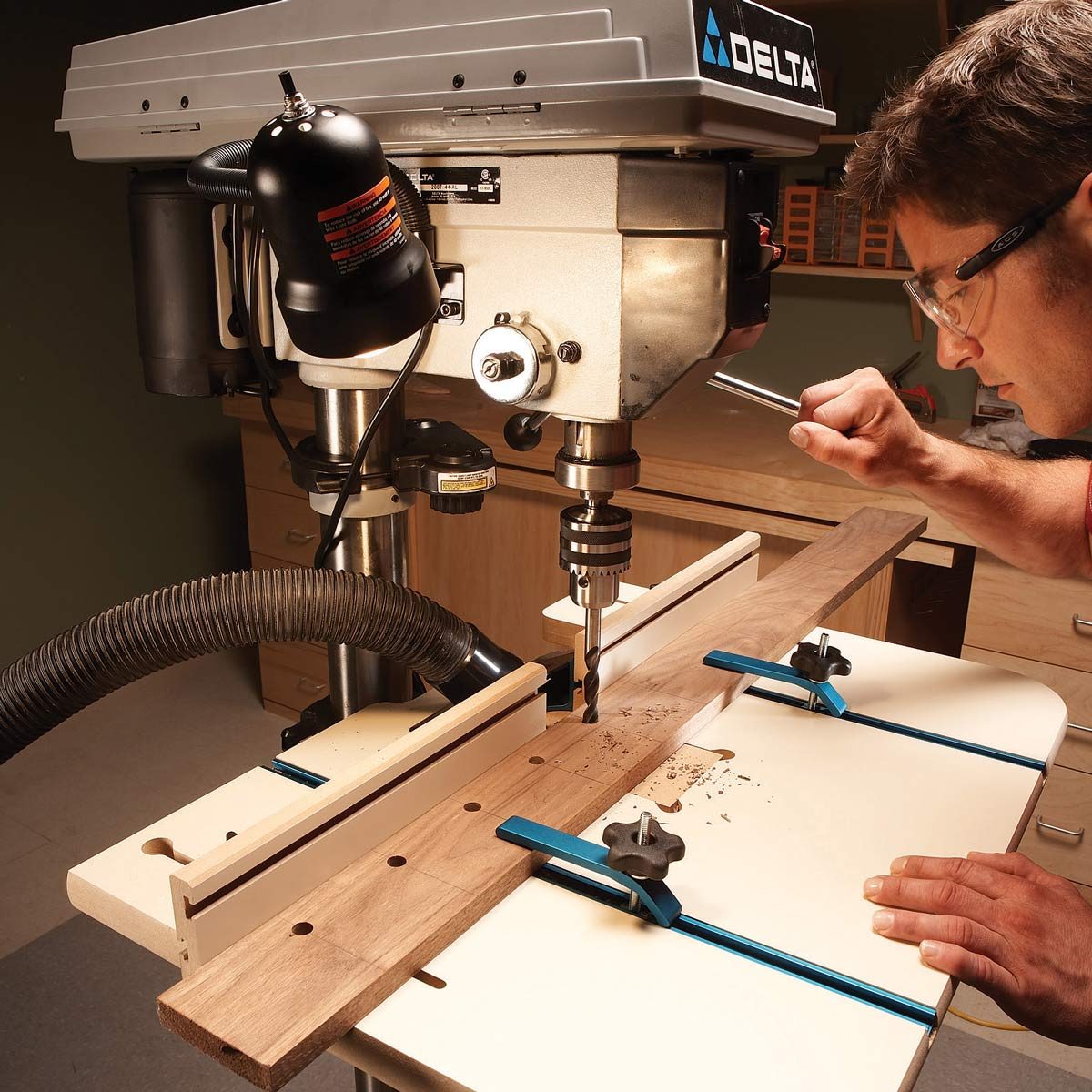So you’ve got a project that requires some heavy-duty drilling? Well, my friend, let me tell you about a magical tool called the drill press. *Bing!* (Get it? It’s like a lightbulb going off in your head!) In this article, we’re going to delve into the world of drill presses and answer that burning question: when should you use one?
Picture this: you’re tackling a woodworking project, maybe building a bookshelf or fixing up an old chair. Suddenly, you realize you need to make perfectly straight, precise holes. That’s when the drill press swoops in like a superhero, with its powerful motor and accurate drilling capabilities. So, when you need those holes to be just right, the drill press is your go-to tool!
But hold your horses, my young DIY enthusiast! There’s more to drill presses than just woodworking. Whether you’re a metalworker, a jewelry maker, or a crafty hobbyist, this versatile tool can be your trusty sidekick. From drilling holes in metal to creating intricate designs in delicate materials, the drill press is there to save the day, offering precision and control that other tools just can’t match.
So, my curious compadres, if you’re wondering when to use a drill press, the answer is simple: when you need accuracy, power, and consistency in your drilling tasks. Whether you’re a seasoned pro or a budding DIYer, a drill press is a must-have addition to your workshop. Now, let’s dive deeper and explore all the incredible things you can accomplish with this mighty tool! Shall we?
1. Precision Drilling: The drill press allows for accurate and consistent drilling, making it ideal for woodworking projects or creating perfectly aligned holes.
2. Metalworking: When working with metal, a drill press provides the stability and power needed to drill through tough materials.
3. Repeated Drilling: If you need to make multiple identical holes, a drill press ensures uniformity and saves time.
4. Mortising: With a mortising attachment, a drill press can be used for creating square or rectangular holes for joinery.
5. Sanding and Polishing: With the right attachments, a drill press can be transformed into a sanding or polishing station, perfect for achieving a smooth finish on projects.
Remember, always prioritize safety when using a drill press and follow the manufacturer’s instructions.

When to Use a Drill Press: A Comprehensive Guide
Are you wondering when to use a drill press? Whether you’re a woodworking enthusiast, a DIYer, or a professional craftsman, a drill press can be a valuable tool in your arsenal. This powerful and versatile machine offers enhanced precision, control, and stability compared to handheld drills. In this comprehensive guide, we will explore the various situations and projects where a drill press shines. From drilling accurate holes to performing repetitive tasks, we’ll cover it all. Let’s dive in and discover when and how to make the most of a drill press.
Benefits of Using a Drill Press
1. Precision: One of the main advantages of a drill press is the ability to drill precise holes with consistent depth and angle. This is crucial for tasks such as doweling, mortising, or creating holes for hardware installation. The adjustable depth stop and angle adjustments on a drill press allow you to achieve exact results every time. You can also use the built-in laser guides or LED lights for enhanced accuracy.
2. Power and Stability: Unlike handheld drills, a drill press is mounted securely to a workbench or floor, providing stability and preventing wobbling. This stability allows you to apply more pressure without risking the drill bit slipping or wandering. Additionally, most drill presses have more powerful motors than handheld drills, enabling them to drill through various materials effortlessly.
3. Versatility: A drill press can do much more than just drill holes. With the right attachments and accessories, you can use it for sanding, buffing, polishing, or even routing. Some drill presses also have tilting tables, allowing you to drill at different angles and expand your range of projects. This versatility makes a drill press a valuable addition to any workshop.
1. Woodworking Projects
Woodworking projects often require precise drilling for joinery, shelf pin holes, or creating mortises. This is where a drill press can truly shine. The stability and accuracy provided by a drill press allow you to achieve tight-fitting joints, perfectly aligned holes, and consistent depths, resulting in professional-looking finished pieces. Whether you’re building furniture, cabinets, or smaller wooden crafts, a drill press will prove invaluable.
For example, when creating dowel joints, a drill press with a specialized doweling jig ensures that the holes in both pieces of wood match perfectly, resulting in a strong and seamless joint. Similarly, when drilling shelf pin holes for adjustable shelves or creating mortises for hinges, a drill press guarantees precise and repeatable results that are essential for functionality and aesthetics.
In addition to drilling, a drill press can also be used for other woodworking tasks. You can attach sanding drums or spindle sanders to smooth curved edges, create decorative patterns, or remove material quickly. With a drum sanding attachment, you can even sand intricate details on turned wooden pieces. The precision and power of a drill press make it a go-to tool for any woodworking project.
2. Metalworking and Metal Fabrication
A drill press is not limited to woodworking; it is also an excellent tool for metalworking and metal fabrication projects. Drilling accurate holes in metal can be challenging without the right equipment, as handheld drills tend to wander or create uneven holes. A drill press eliminates these issues by providing stability and control, ensuring clean and precise holes.
Whether you’re working with sheet metal, steel, aluminum, or other metals, a drill press can handle the task. You can use it to create holes for rivets, bolts, or screws, or drill larger holes for plumbing or electrical installations. The speed settings on a drill press allow you to adjust the drilling speed according to the type of metal you’re working with, ensuring optimal results.
Additionally, a drill press equipped with a tapping attachment can even facilitate tapping threads in metal. This eliminates the need for manual tapping and ensures consistent and accurate threading.
3. DIY Home Improvement Projects
If you’re an avid DIYer and frequently undertake home improvement projects, a drill press can be a game-changer. From installing shelves and cabinets to assembling furniture or building custom pieces, a drill press provides the precision and efficiency needed for a professional finish.
When installing hardware, such as drawer pulls or handles, a drill press allows you to align and drill accurate holes in multiple pieces, ensuring consistency and a uniform appearance. It also eliminates the risk of the drill bit slipping and damaging the surface of your workpiece.
In DIY woodworking projects, a drill press is particularly useful for creating pocket holes. This technique involves drilling an angled hole at the edge of a piece of wood, allowing screws to be driven in at an angle and hidden from view. Pocket holes are commonly used in cabinetmaking, furniture assembly, and other woodworking applications. A drill press with a specialized pocket hole jig and step drill bit ensures precise and effortless pocket hole creation.
4. Metal and Woodworking Classes and Workshops
Learning new skills and techniques in metal or woodworking classes or workshops often involves drilling precise holes. A drill press is an essential tool in these learning environments, providing students with the means to practice accuracy and master essential drilling techniques.
Whether students are learning basic woodworking joinery or advanced metal fabrication, a drill press offers the necessary stability and control for successful projects. With a drill press, students can focus on perfecting their technique and understanding the principles behind accurate hole placement and depth control. This foundation sets them up for success in their future endeavors in the metal and woodworking industries.
It’s also worth noting that many vocational schools, technical institutes, and community colleges that offer metal and woodworking courses have well-equipped workshops with drill presses readily available. Students can utilize these resources to gain hands-on experience and develop their skills in a safe and supervised environment.
Additional Uses for a Drill Press
While the above categories cover some of the common scenarios where a drill press is essential, its usefulness extends beyond these applications. Here are a few additional situations where a drill press can come in handy:
1. Jewelry Making:
- A drill press allows jewelry makers to create precise holes in various materials, such as metals, gemstones, or beads.
- It ensures consistent results and allows for the creation of intricate designs with ease.
- A drill press equipped with a flex shaft attachment can also be used for polishing and buffing jewelry pieces.
2. PCB Drilling:
- When designing and prototyping printed circuit boards (PCBs), a drill press with a specialized PCB drill bit provides accuracy and precision.
- The adjustable speed settings on a drill press accommodate the different sizes of drill bits required for drilling holes and creating vias in PCBs.
3. Hobbies and Crafts:
- Whether you’re into model making, dollhouse construction, or any other craft hobby, a drill press can be a valuable tool.
- It allows for drilling accurate holes in miniature pieces, creating custom jewelry, or even carving intricate designs in wood or other materials.
Conclusion
A drill press is a versatile and powerful tool that can elevate the quality and precision of your projects. From woodworking to metalworking, DIY projects to professional applications, a drill press proves indispensable in many situations. Its ability to deliver consistent accuracy, stability, and control makes it an essential addition to any workshop or learning environment. So, the next time you find yourself asking when to use a drill press, remember the wide range of projects and tasks where it excels. Embrace the capabilities of this remarkable tool and take your craftsmanship to new heights.
Key Takeaways: When to Use a Drill Press?
- A drill press is ideal for precise drilling tasks where accuracy is crucial.
- Use a drill press when drilling through tough materials like metal or hardwood.
- It’s recommended to use a drill press for repetitive drilling tasks to maintain consistency.
- If you need to create clean and straight holes, a drill press is the right tool.
- When working on projects that require controlled depth and speed, a drill press is essential.
Frequently Asked Questions
Welcome to our FAQ section, where we answer some common questions about when to use a drill press. Whether you’re a beginner or an experienced DIYer, understanding the right situations to use a drill press is important for achieving accurate and efficient drilling results. Read on to find answers to your burning questions!
Q: Can I use a drill press for any drilling job?
A: While a drill press is a versatile tool, it’s not suitable for every drilling job. Drill presses are best used for precision drilling tasks that require consistent depth, accuracy, and control. They are ideal for drilling holes in metal, wood, and other materials where precision is crucial. For larger holes or unconventional drilling angles, it’s best to explore other tools like handheld drills or specialized drill attachments.
Remember, always choose the right tool for the job. Assess the size, material, and precision requirements of your drilling project to determine if a drill press is the appropriate tool to use.
Q: When should I consider using a drill press instead of a handheld drill?
A: There are several scenarios where using a drill press can offer distinct advantages over a handheld drill. Firstly, when drilling multiple holes in a repetitive pattern, a drill press can ensure consistent depth and alignment across all the holes, saving you time and effort. Additionally, when drilling large diameter holes, the stability and power of a drill press allow for smoother, controlled drilling.
Furthermore, if precision is critical, such as when working on fine woodworking projects or drilling into metal, a drill press provides greater control, accuracy, and stability compared to a handheld drill. Ultimately, it boils down to the size, complexity, and precision requirements of your project.
Q: Do I need a drill press for basic household repairs?
A: For most basic household repairs, a handheld drill will suffice. The portability and versatility of handheld drills make them suitable for various tasks like hanging shelves, installing curtain rods, or assembling furniture. However, if you frequently undertake DIY projects that involve more precise drilling, a drill press could be a valuable addition to your toolkit.
Consider your specific needs and the types of projects you typically undertake. If you find yourself frequently in need of precise, accurate holes or working with materials that require stability and control, investing in a drill press may be worth your while.
Q: What safety precautions should I take when using a drill press?
A: Safety should always be a top priority when operating any power tool, including a drill press. Here are a few key safety measures to follow:
1. Eye Protection: Wear safety glasses or goggles to protect your eyes from flying debris.
2. Clamping: Always secure the workpiece firmly before drilling to prevent it from spinning or moving unexpectedly.
3. Speed and Feed Settings: Pay attention to the recommended speed and feed settings for the specific material you are drilling. Operating at the wrong settings can lead to damage or accidents.
4. Guard Usage: Ensure that the drill press guard is in place and properly adjusted to protect your hands and fingers from the drill bit.
By following these basic safety guidelines and reading the drill press manual for any specific safety instructions, you can minimize the risk of accidents and ensure a safe drilling experience.
Q: Can I use a drill press for non-drilling tasks?
A: While drill presses are primarily designed for drilling, they can be adapted for certain non-drilling tasks with the use of specialized attachments or accessories. Some drill presses have sanding drum attachments that allow for sanding operations, while others can accommodate mortising attachments for creating square or rectangular holes.
However, it’s important to note that these applications may require additional accessories and setup adjustments. Always refer to the drill press manufacturer’s instructions and recommendations when using attachments or attempting non-drilling tasks.

What’s a drill press? Do you need one? | Mere Mini
Summary
A drill press is a handy tool to have when you need to make precise holes. It is best used when drilling through hard materials like metal or wood that require accuracy and stability. When dealing with larger projects or repetitive drilling tasks, a drill press is a safer and more efficient option than a handheld drill. It allows you to set the depth and angle of the holes, ensuring consistent results every time.
However, a drill press is not necessary for every drilling task. If you are working with softer materials like plastic or thin sheets, a handheld drill may be sufficient. Additionally, if you only need to make one or a few holes, using a drill press may be overkill. It is important to consider the nature of your project and the material you are working with before deciding whether to use a drill press.
